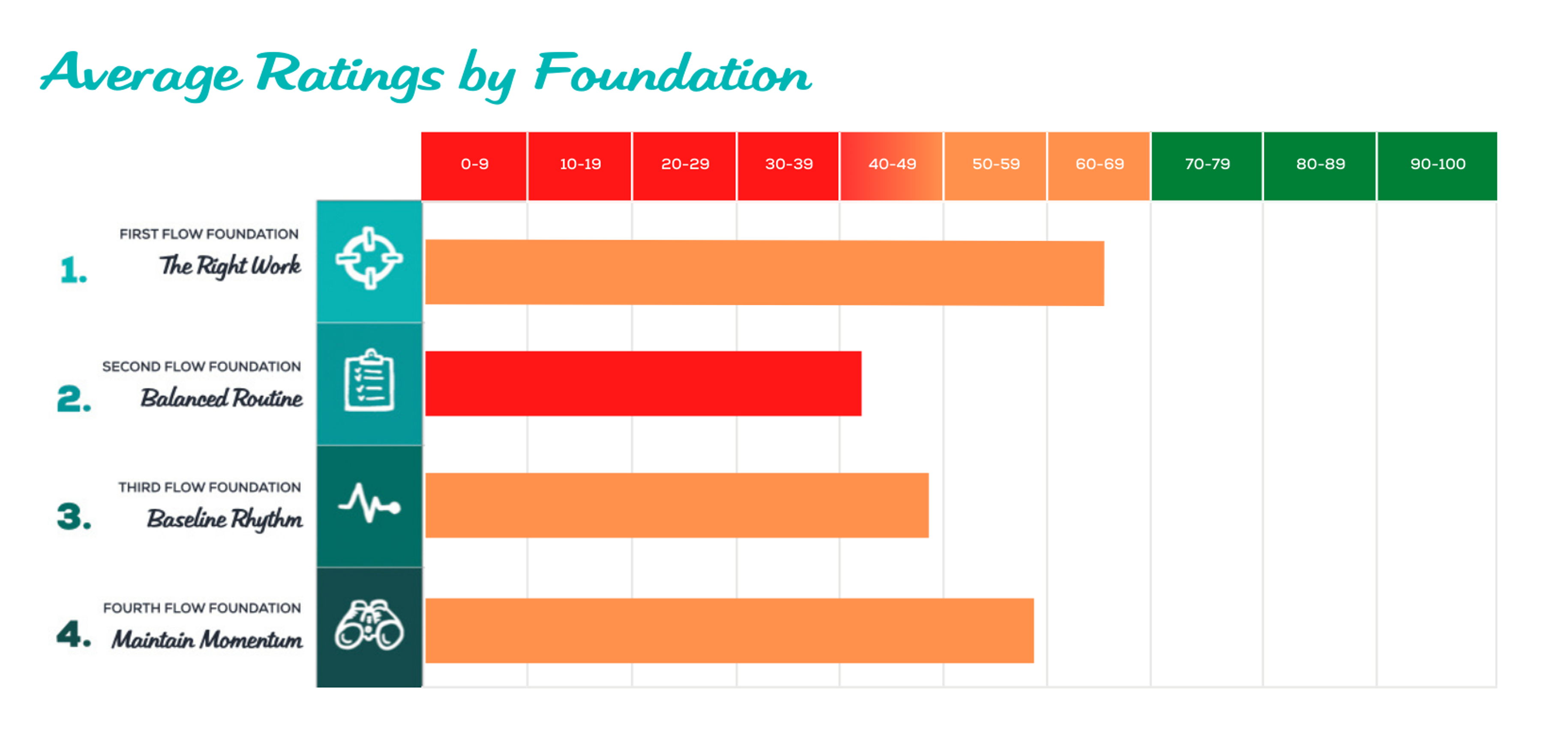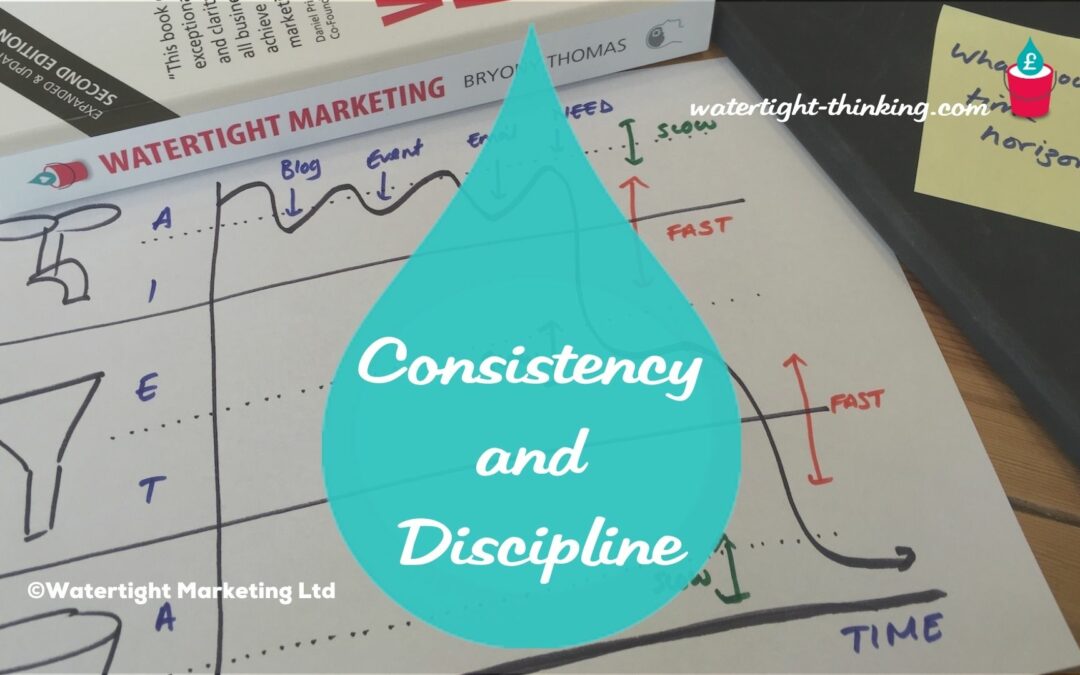Reading Time: 5 Minutes
Consistency of activity is probably one of the hardest things to achieve in marketing. According to our research, it’s seen as challenging by all roles, whether in marketing or not, and all business sizes. We explore here why this is so and what you can do about it. ~ Rachael Wheatley | MD, Watertight Business Thinking
There are all sorts of reasons why it’s not easy to achieve consistency in marketing.
Perhaps you don’t have the resources or right people to help you ensure things happen regularly. Maybe there’s a gap in processes or systems that would help you get there. Or you might find you get regularly side-tracked with left-field requests and on-going projects.
Whatever the reasons, we’ve noticed that marketing activity often yo-yos in sync with the delivery and operational demands of the business. This leads to sporadic marketing which is less likely to gain momentum and will almost certainly be ineffective.
What does good look like?
The third Foundation, Baseline Rhythm, focuses on establishing a regular cadence for your marketing activities. This rhythm should align with your business’s operational tempo and market dynamics. This is where actioning the plan and keeping on track sits. It includes budgeting and measurement and is reliant on consistent resourcing.
We define this Foundation as “a commitment to marketing that is consistently delivered at intervals and pace matched to your market”. Just like a healthy heart has a regular beat, a successful marketing strategy requires a steady rhythm. This involves setting regular intervals for planning, execution, and review of marketing activities. A consistent rhythm helps in maintaining momentum and ensuring that marketing efforts are continuously aligned with business objectives .
The kind of person you need to make this Foundation succeed is someone who thrives on process and monitoring. They’ll be the ones who love the data and want to delve into it to see what it’s saying and showing. They make sure the plan goes to plan, and adapt and flex it as needed. They’ll identify and create the right processes and guidelines and manage people, money and time resources. They’ll keep things on track – budget, plans, activities, suppliers, metrics – and help to overcome any challenges in these areas.
Take our marketing fitness test to benchmark your company: find the test here
Why marketing discipline is rated so poorly
Because marketing yo-yoing is so common, we weren’t surprised to find in our research results that 89% of respondents felt that their marketing rhythm and discipline needs attention, scoring it 48% on average. According to our ratings, that’s only just above ‘red’ and the second lowest rated Foundation.

It was rated low by all respondents in all roles and in all business sizes. MDs or business owners are most frustrated by this, rating this Foundation at 44%. They are often high energy people for whom nothing ever goes fast enough which may explain their particular frustration here.
We also found that smaller businesses find it the hardest. That isn’t surprising given that they are frequently stretched on resources, with one marketer or a small team endeavouring to cover all bases on the marketing front – planning, strategy, doing, measuring, budgeting and project-management.
A recurrent theme in our research was the gap between knowing and doing. As it relates to this Foundation, marketers know what the timescales are; they understand how long it takes for a customer to make a decision and how long they need to nurture those relationships over what period of time and how frequently to be in contact. However, that doesn’t always translate into the cadence, rhythm and discipline of marketing activity where a business is regularly communicating with customers, engaging with warm prospects and showing up in places they know potential buyers hang out.
The disconnect between knowing and doing also surfaces here in the mismatch between the speed at which people make decisions to buy and the timing of the marking. If what you sell is a considered purchase, your prospects will take their time to come to a decision. They’ll need information, several conversations and reassurance. Other things will happen in their world which means they might defer a decision. They might need to circle back to their thinking and remind themselves of your offering and its benefits.
All the while, it’s a marketing job to keep connected and on their radar by being relevant and helpful over what can be weeks, months and sometimes years! This is one of the areas that can suffer from lack of consistency. If you fall off their radar, prospects and customers – even those who might derive real value from your products or services – can easily forget you.
The three actions to take
To make sure your Baseline Rhythm scores at last amber, if not green, here are three things you can do:
- Make your own assessment of the strength of this Foundation (look at our definition above and do our test) and consider ideas you or your team have that would plug any gaps.
- Then have a conversation with your MD to agree what good looks like in terms of rhythm and discipline and talk him through your ideas to address any concerns they have.
- Spend the time setting up processes and measurement frameworks so that systems can provide the consistency as much as possible. It might feel onerous in the short term but it will free up your time and make you more productive in the long run. Look at:
- Interval planning: Set regular intervals for different marketing activities such as content creation, campaign launches, and performance reviews.
- Resource planning: Ensure that your marketing team has the resources needed to maintain this rhythm. This includes budget, tools, and personnel.
- Process optimization: Continuously refine your marketing processes to improve efficiency and effectiveness. Use feedback and performance data to make informed adjustments.
- Stakeholder engagement: Keep all stakeholders informed and engaged with your marketing rhythm. Regular updates and reviews help to maintain alignment and support.
Taking these actions will ensure you have good marketi0ng discipline resulting, like a heartbeat, in the Baseline Rhythm you’re looking to put in place.
Download the research paper here

Subscribe to the CMO Toolkit
Would you like to get your hands on the tools, frameworks, templates, workshop packs, slides, and analysis tools we use with our clients? It’s all waiting for you.

Rachael Wheatley
Managing Director, Watertight Thinking
Rachael brings over 30 years’ of marketing experience, with a particular focus on building and developing effective marketing teams that are able to act as a strategic driving force across an organisation. She has worked with Watertight since 2014 as a Master Practitioner and joined the business as MD in 2022.


